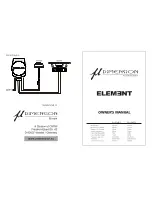
C
D
WALL & CEILING SURFACES
Now that we’ve covered where you should
put your speakers, let’s consider where you
CAN put them.
The installation depth requirements for the
AuraPro series speakers, please refer to
the specifications table on page 10.
(measured from the outside surface of the
wall). This means that they can be installed
in any space wide and deep enough for
them, including most ceilings.Ceiling
plasterboard (or lath and plaster in older
homes) acts as a superb speaker baffle.
Because the depth of AuraPro series
ceiling speakers is deeper than typical 2
̋
x
4
̋
wall studs, AuraPro series speakers
cannot be installed in most walls.
Avoid:
• Ceilings covered only with thin veneer
paneling – the surface isn’t rigid enough
and can cause annoying vibrations and
buzzing.
• T-bar “drop ceilings” with very thin
fiberboard panels which can buzz and
vibrate. If you suspect this will happen,
reinforce the drop-in panel with wood or
particle board.
• Any wall which can’t provide proper depth
(clearance) for the back of the AuraPro
series speakers to protrude. This includes
brick
or concrete walls where the wallboard or
paneling is attached to thin furring strips.
• Ceilings where you know that there are
pipes, heating ducts and ESPECIALLY
AC wiring in the general vicinity.
SPEAKER WIRE PATHS
The last consideration is the obstacle
course that lies between the speakers’
hoped-for mounting positions and your
stereo system.
Wire can be run through crawl spaces that
lie above your ceiling or below the floor,
through basements of second stories, or
simply along the perimeter of your listening
room. We cover each of these options in
detail in the “Running connecting wires”
section of this manual.
In general, you should pay particular
attention to the following areas:
• Avoid running speaker wires close to
house electrical wiring for any distance. If
you have to run them parallel, make sure
to space the speaker wires at least two
feet from the AC line. It is, however, OK
for speaker wires to cross paths with AC
line or go through the same hole together
with house wiring if they separate before
and after.
• Make sure that the entire path between
speakers and amplifier is clear and not
obstructed by a major floor or ceiling joist
or masonry wall which you won’t be able
to drill through.
• Remember that the other end of the wires
has to come out somewhere to connect
with the amplifier. Confirm ahead of time
that you can drill an outlet hole easily and
in an unobtrusive spot.
DRAWING 5
Both the speaker frames and the grilles can
be painted, if desired. We recommend
doing this before installation. Always paint
the grilles separately from the speaker
itself.
First, remove the white scrim cloth from
behind the grille. The grilles should only be
spray painted very lightly to avoid clogging
the fine mesh of the grille and restricting
the sound. Once the grille is dry, replace
the scrim cloth by gently placing it behind
the grille. No adhesive is necessary gravity
will keep it in place (see Drawing 5).
Only install the speakers and grilles once
the paint has dried thoroughly.
Wallboard is an easy surface in which to
make a relatively neat hole. Actually, the
hole doesn’t even have to be that neat,
since the speaker’s outer frame will cover
it. Just make sure you don’t make it any
bigger than the template. In the following
steps, you’re going to locate a section of
ceiling between the wood framing or in the
wall between two studs, mark the outer
boundaries of the hole, drill a small hole in
the center to confirm
your location and then cut the main hole.
1. First you must determine the location of
your ceiling supports so that the speaker
can be approximately centered between
them. There are several ways to go about
this:
·
Tap on the surface and listen to the result-
ing “THUMP”. When it’s deeper, you’re
between studs. When it’s sharper and more
flat-sounding, you’re close to a stud.
·
Use a stud-finder, a simple little device
which works by locating the studs behind a
wall.
·
Identify wall studs by the position of
electrical outlets or switches. There will be
a stud either directly to the left or right of an
electrical fixture. This gives you a point of
measurement, since studs are either 18 or
16 inches apart in newer houses, 12 inches
apart on pre-WW2 homes.
CUTTING HOLES
FOR THE SPEAKER(S)
PAINTING THE
SPEAKER(S) AND
GRILLE(S)
DRAWING 6
4






























